
Best Global Brands 2012
.pdf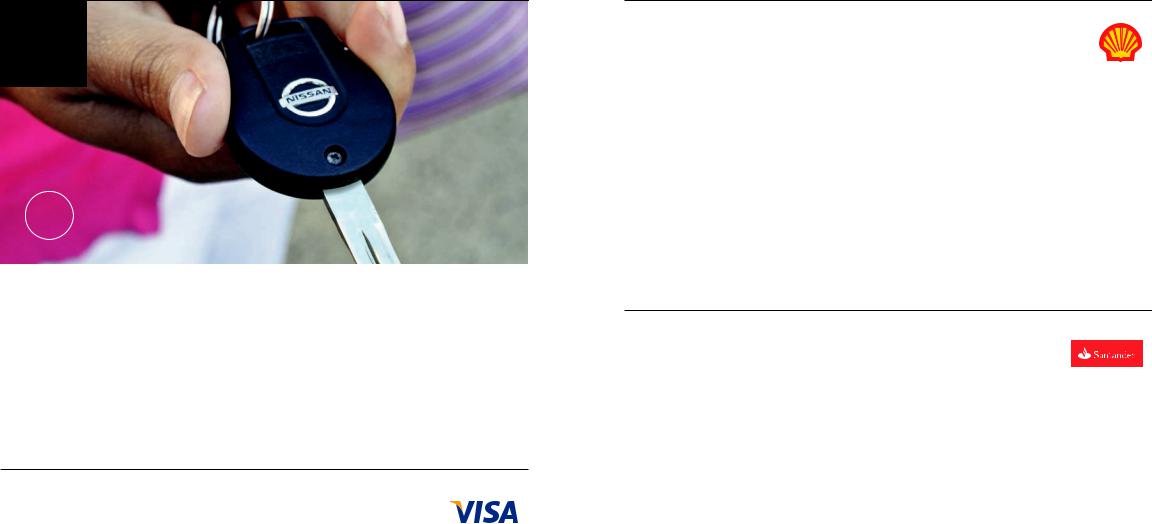
73
Nissan
+30%
4,969 $m
top riser
The Nissan brand continues to generate waves of momentum. Nissan demonstrated a fair amount of agility by recovering quickly from natural disasters and by growing market share with an aging lineup. With the addition of new models beginning to roll out, the brand should maintain an upward trajectory. A significant part of Nissan’s success has been its ability to push the envelope on innovation: from the next-genera- tion NYC taxi and groundbreaking Nissan DeltaWing race car at LeMans, to the bold designs
of vehicles such as the Nissan Juke. Winning Japan’s Car of the Year Award, the Nissan LEAF proved that a zero-emissions vehicle can not only transport humans, but also power an ordinary household. The brand continues to expand in Europe and has established a strong presence in emerging markets such as Russia and China. With a commitment to continue to improve the service experience, Nissan has an opportunity to break away from a dependence on incentives and fully leverage the power of its brand.
74
Visa
+10%
4,944 $m
Aiming to bring the digital currency marketplace to new heights, Visa is working to help users around the world leave the inconvenience of checks and the risks of cash behind. Through its “Currency of Progress” mission, Visa is looking to make digital currency the new norm. The brand continues to develop technologies for its online and mobile platforms, most recently showcased at the 2012 Olympic Games in London, where the brand was a main sponsor. Unfortunately, the sponsorship was blemished when credit card systems failed during peak events. Due to Visa’s agreement with the International Olympic Committee, there was no fallback to another card provider or merchant system, which meant fans
were unable to make purchases — and had only Visa to blame. The brand faced another challenge this year when one of its service providers experienced a security breach that put over a million consumers at risk for identify theft. Visa turned the incident into proof of its commitment to customers, immediately removing the provider from its list of approved vendors. Despite these mishaps, Visa’s heavy media campaign during the Olympics and other major sporting events have helped the brand maintain a positive presence in the minds of consumers. Looking forward, Visa may have di culties if it continues to neglect a clear and appropriate articulation of its brand promise and benefit to consumers.
75
Shell
+7%
4,788 $m
Given the controversy surrounding the safety performance of the category, building a positive public image is di cult for oil brands. Shell, however, rose to the challenge and, despite an oil spill o the coast of Nigeria, managed to maintain a strong brand image. That image, however, is at risk of becoming tarnished as Shell dives into the highly controversial business of Arctic drilling. Shell’s actions in the Arctic have made it the target of culture jamming, a tactic that involves subverting the media as a form of protest. In this case, Greenpeace and activist duo, the Yes Men, created an elaborate hoax in which
they impersonated Shell and used a fake website and video to make their statement. Perhaps wisely, Shell has not reacted strongly to the stunt. It is too early to predict how Arctic drilling will a ect profits and how pressure from environmental activists will a ect Shell’s brand strength. To safeguard its image — and avoid the negative consequences and cost of an acci-
dent — Shell might consider cooperating with those who want to develop a vision for the Arctic that is based on science, preparedness, and protecting the health of ecosystems.
76
Santander
–6%
4,771 $m
Over the past two decades, Santander has emerged as one of Europe’s largest banks and was named the 2012 best retail bank in the world by Euromoney. Santander has demonstrated a commitment to increasing its level of customer satisfaction by developing a special program for managing customer concerns. The program ensures quick resolution of complaints by channeling them to specialized units that keep the customer informed of progress where identifying the main causes of common customer complaints so steps can be taken to correct them. Although it is feeling the pain of both a slow-to-recover US economy and the European debt crisis, the bank’s investments in South America have shielded Santander from feeling the e ects as much as its peers. Santander, however, is not totally immune — with significant losses over the first two quarters of 2012, Santander
is one of 16 Spanish banks that had their credit worthiness downgraded by Moody’s Investors Service. The brand’s reputation also took a hit from high-profile legal investigations involving two of its most senior executives. This all comes as Santander is introducing US consumers to its global brand following its acquisition of Sovereign Bank. Santander plans to drop the Sovereign name early next year and has been careful to demonstrate its commitment to the US by continuing to invest in new technology and advertising for its US operations. Santander has been a solid, growing brand for decades, and has emerged as one of the world’s biggest banks. But the European debt crisis and the brand’s close association with Spain will make it di cult for Santander to continue its winning streak.
58 |
Best Global Brands 2012 |
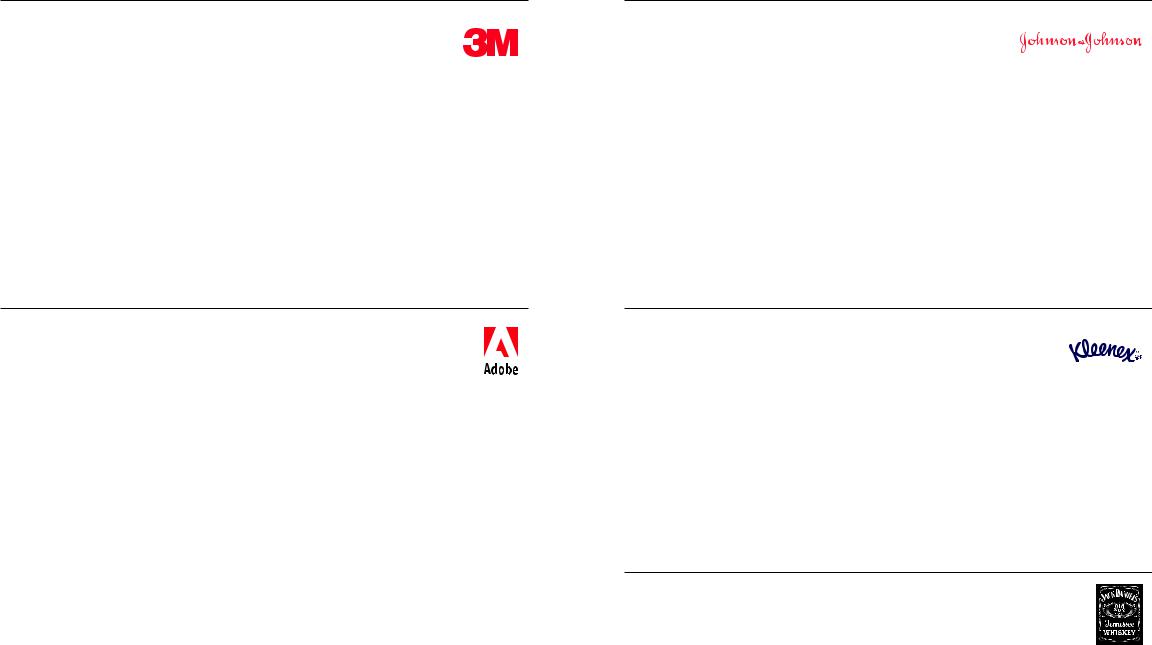
77
3M
+18%
4,656 $m
It has been an impressive year for 3M, which has strengthened its brand in many areas and in doing so has increased its brand value by 18%. The company has continued to win accolades for its environmental record, especially in pollution prevention, and its commitment to sta . But it is innovation that separates 3M from the pack — a territory 3M has strongly reclaimed in the past year. Its strong R&D culture delivers a wide range of products that meet customer needs across both B2B and B2C audiences, and improve the environment (the company ranked #12 in Interbrand’s Best Global Green Brands 2012).
Reinforced by consistent and e ective brand communications, 3M continues to build trust and respect among customers — earning the company leading global market positions in each of its business areas, where a closer connection has been achieved between strong product brands and the 3M corporate brand. In 2011, 3M launched a new R&D facility in India, slated to bring in significant revenue within the next five years. And despite the recession, 3M managed a sales increase in the first quarter of 2012, making the future look very bright indeed under new CEO, Inge Thulin.
78
Adobe
+9%
4,557 $m
Adobe continues its focus on“changing the world through digital experiences” by expanding its breadth of o erings to consumers and providing them with end-to-end solutions for creating, publishing, marketing, and optimizing content. Specifically, with the launch of the Creative Cloud, Adobe brings an array of Digital Media tools to users under one umbrella, elevating the creative process from one that is currently
tooland box-driven to something more innovative, accessible, and inclusive. Understanding that the human urge toward creativity is at the core of their business, Adobe also conducted an in-depth global study called the Adobe State of Create. Strategically released at the company’s CS6 launch event this spring, the study revealed, among other interesting findings, that access to creativity-boosting tools is, according to the
majority of respondents, one of the most important keys to expressing one’s creativity. By acknowledging the deeper need that draws people to their o erings and moving beyond products to suites and services, Adobe is beginning to build relationships with users at the highest level and transform the way their brand is perceived: from tool maker to creative advocate. Who better to produce creative suites than experts on creativity? In this way, Adobe has solidified its relevance to a diverse global audience and fortified its brand at the masterbrand level,with an authentic brand vision around creativity that is clearly resonating. Revenues have exceeded company expectations, demonstrating that Adobe is on the right track and responding admirably to the fast-changing needs of the creative and business marketplace, as well as the universal human need to create.
79
Johnson & Johnson
+8%
4,378 $m
Johnson & Johnson (J&J) rebounded strong in 2012, demonstrating the resilience of its brand. Alex Gorsky, a J&J veteran very familiar with the safety and quality issues that have plagued the company in the recent past, was named CEO. While safety and quality issues like supply shortages and recalls of Tylenol products continued in 2012, J&J’s responsiveness in updating safety protocols, and its commitment to social responsibility have enabled the company to bounce back — and establish itself once again as a trusted corporate brand. J&J continues to expand its consumer health presence in emerging markets. Outside of
the consumer health space, J&J continues to grow its presence and influence. Most apparent is the Medical Device and Diagnostic division’s acquisition of Synthes, a leading global medical device company. By merging Synthes with its DePuy franchise to form the new DePuy Synthes Companies, J&J has created the world’s largest, most innovative orthopedic and neurological business. Driven by its credo to improve the health and well-being of people around the world, J&J continues to demonstrate that a strong brand can help a company weather all storms.
80
Kleenex
–7%
4,360 $m
Although Kleenex’s social media e orts were lauded by critics and consumers alike, its brand value declined over the past year. Kleenex outspent competitors in advertising, but store brands were the ultimate victors in the category. To reclaim some of this lost market share, Kleenex rolled out Kleenex Cool Touch tissue, and let consumers try the new tissues for free if they sent a Share Package to a friend or family member. Kleenex also launched its“Shield Sneeze
Swish” campaign, dedicated to teaching consumers how to prevent colds from spreading. The Kleenex product was originally made of excess material and, today, its cartons are also fully recyclable. Despite its decline in brand value, Kleenex remains a global icon. Its heritage in the facial tissue industry, along with its dedication to consumers and product innovation, continue to position the brand as a worldwide leader in its industry.
81
Jack Daniel’s
+1%
4,352 $m
Despite celebrating its 160th birthday, Jack Daniel’s is keeping pace with the times. The Tennessean whisky has more Facebook friends (1.8 million) than any other alcohol brand. Jack Daniel’s has also revamped its website and e ectively used Twitter to build buzz around its new flavored whiskey, Tennessee Honey. True to its Tennessee roots, Jack Daniel’s still upholds its values of authenticity and integrity. To ensure that all employees understand the brand’s heritage and
values, Jack Daniel’s brings them to Tennessee for “Camp Jack.” The Jack Daniel’s Distillery also partners with the University of Tennessee to preserve and restore trees native to its home state. Jack Daniel’s commitment to core values and corporate citizenship bodes well for the future. Having launched its first flavored whiskey and pre-mixed alcoholic drinks, the iconic brand is hoping to expand into new markets and make this century as successful as the last.
60 |
Best Global Brands 2012 |
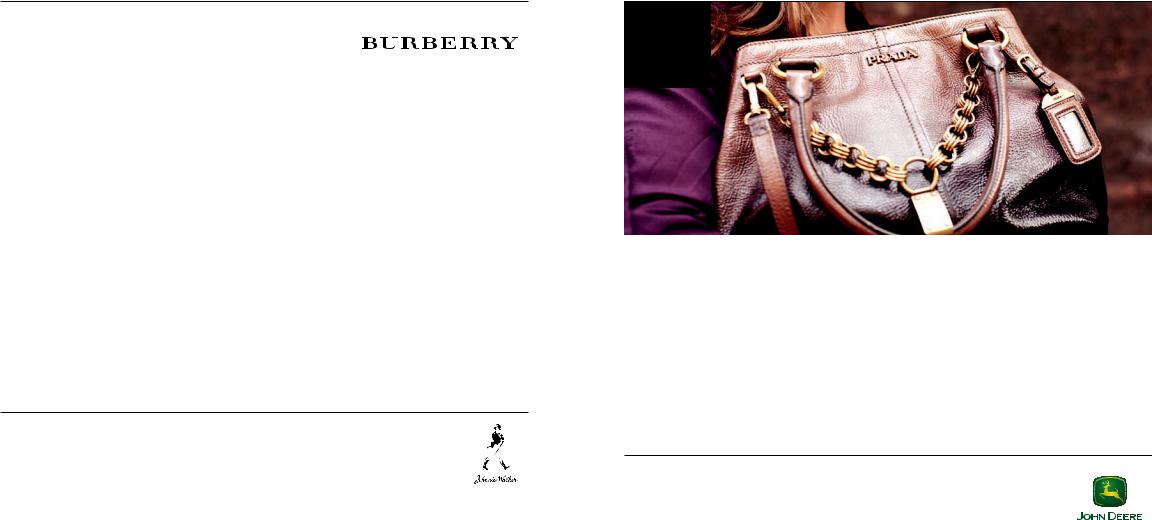
82
Burberry
+16%
4,342 $m
Quintessentially British, yet relevant worldwide across genders and generations, Burberry continues to drive its momentum as a leading global luxury brand. Under the leadership of its CEO, Angela Ahrendts, Burberry’s digital positioning ensures consistency of experience across channels and enriches the depth and accessibility of that experience — thrilling consumers every time. Late last year, launching simultaneously across digital and traditional platforms, Burberry Body was the brand’s most successful fragrance launch to date. The runway show experience on Burberry.com evolved again this year, with motion-reactive 360-degree technology enhancing online viewing of the collection. Burberry’s“Runway to Reality” initiative also allows consumers the opportunity to purchase directly from a video of a Burberry runway show. A leader when it comes to reaching consumers in innovative, high-tech ways,
Burberry was one of the first brands to embrace social networking through its website and Facebook page. The brand also aggressively advertised on digital platforms, well ahead of other notable luxury brands. Cementing a top spot on social media in the luxury sector, the brand doubled its numbers for both Facebook fans and YouTube views, and tripled its number of followers on Twitter this year. Art of the Trench, a website that is“a living celebration of the Burberry trench coat and the people who wear it,” also saw a 60% lift in pageviews, with over 19 million users from 200 countries. However, despite these impressive numbers, Burberry’s growth rates, once supported by a buoyant Chinese market, are now starting to slow. To continue its growth trajectory, this classy British label will have to deftly navigate the changing landscape in developing markets to remain a global luxury powerhouse.
83
Johnnie Walker
+12%
4,301 $m
Johnnie Walker, a leading producer of Scotch whisky, has had a good year and continues to play a leading role in the Diageo portfolio. Selling 17 million equivalent units of its Red and Black labels in the year ending June 2011, Johnnie Walker remains the world’s best-selling whisky and best-selling spirit by value. In the six months following, overall sales went up by 15%. Despite the huge volume, the brand retains its premium positioning — it is the top premium Scotch whisky brand globally. The brand’s simple and elegant architecture translates into a clear di erentiation from its competitors and strong understanding by consumers. Its new“Walk with
Giants” campaign in Africa, as well as its partnership with influential Chinese blogger HanHan and first Latino spokesperson, DJ Alex Sensation, are strengthening Johnnie Walker’s appeal in emerging markets, helping to o set challenges in Europe. The brand’s sponsorship of the Johnnie Walker Classic in Asia and the Johnnie Walker Championship at Gleneagles keep the brand highly visible while reinforcing its Scottish roots. At the same time, through careful and consistent management, the brand has remained relevant to customers at every price point. Johnnie Walker’s future will remain very promising if it doesn’t stray from its current path.
84
Prada
New
4,271 $m
Though in existence for nearly a century, Prada approaches each season with a flair that is bold and innovative, yet distinctly its own. As a result, Prada consistently exudes an admirable degree of self-confidence, which only makes it more desirable, and steers the brand away from provocation for provocation’s sake. What ultimately draws consumers to the Prada brand (and moves them to value its very name across continents and cultures) is its sense of self-assur- ance, won through constant experimentation and a proven ability to dictate tastes and trends
rather than chase them. Figures reflect the power of this love a air, and underpin Prada’s return to our Best Global Brands report. The brand’s continued growth in revenues (26% in 2011) is fueled mainly by over 250 DOS (Directly Operated Stores) worldwide — a network which is expanded with a careful eye on increasingly well-traveled customers. While Prada boasts an extraordinary indi erence to the di cult economic climate, the only caution may be the extent to which the Chinese market alone will be the brand’s center of gravity, both commercially and otherwise.
85
John Deere
+16%
4,221 $m
John Deere, one of the world’s leading manufacturers of agricultural machinery and forestry equipment, celebrates its 175th anniversary this year with a sharp increase in brand value. The Moline, Illinois-based organization attributes its longevity to the fact that its core values (integrity, quality, commitment, and innovation) are central to the brand’s corporate citizenship strategy and still vital among the 60,000 employees worldwide. The company remains “committed to those linked to the land” by sponsoring agricultural-development training programs in countries like Russia and Ukraine. This commitment and authenticity clearly resonate with the brand’s core audience and
beyond — as the ubiquitous John Deere cap can attest. Without losing sight of its authentic core, John Deere continues to tap into the growth potential of the construction equipment market. With most of John Deere’s construction sales in North America, increased demand in countries like Russia, India, China, and Brazil is expected. Economic uncertainty, adverse weather in countries such as the US and India, and a recent production delay of a new combine line have contributed to John Deere lowering its full-year net income forecast. All signs indicate, however, that the organization is well-positioned to overcome such challenges and make its 176th year its best yet.
62 |
Best Global Brands 2012 |
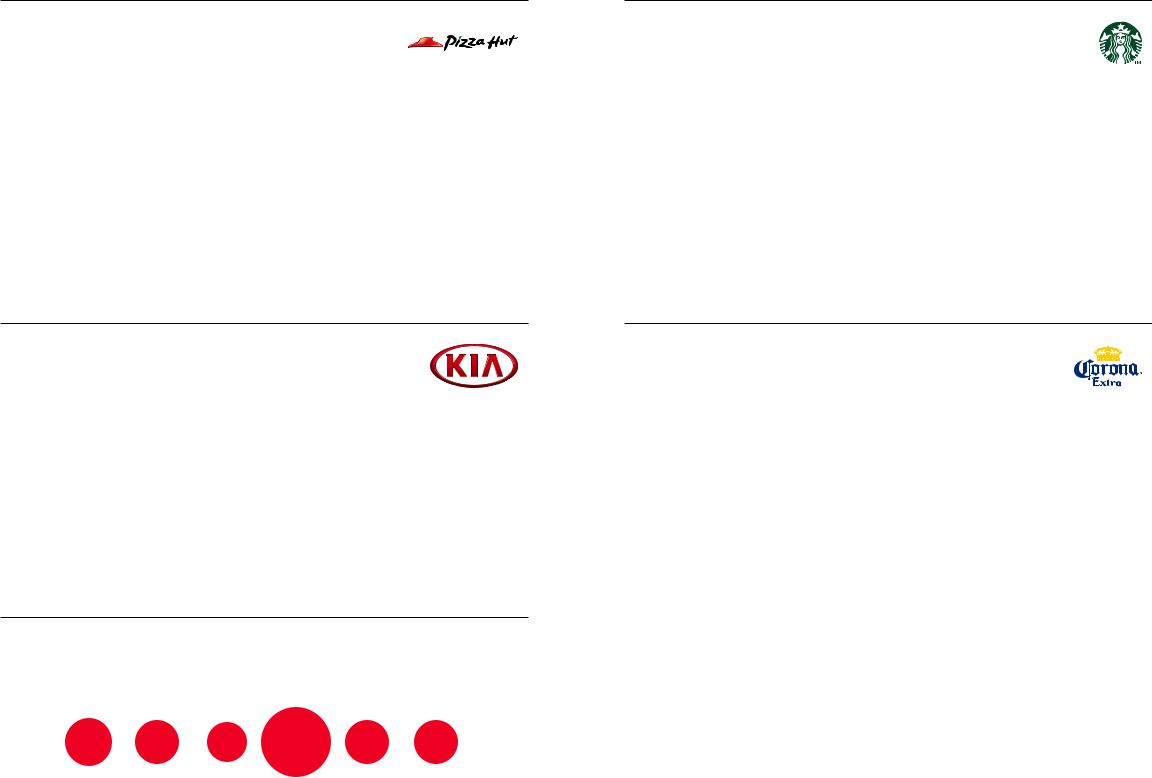
86
Pizza Hut
+2%
4,193 $m
Pizza Hut, part of the Yum Brands portfolio, kicked o 2012 with its“Top This” campaign. It used Facebook to give consumers the chance to appear in a pre-game Super Bowl commercial, illustrating how Pizza Hut is deepening its connection with consumers through social platforms. With 7,200 restaurants in the US and 5,600 in other countries, Pizza Hut has introduced new products to appeal to local tastes. In the Middle East, it introduced“Crown Crust Pizza.” In China, the chain opened restaurants with a casual dining setting that o ers typical American dishes. These vast regional di erences, along with the fact that the brand has gone
through numerous brand image changes over the past decade, have left some customers confused about Pizza Hut’s core values and positioning. In May 2012, the brand took aim at the sandwich market — namely Subway — by introducing a new pizza sandwich called the P’Zolo™ with the tagline“See ya subs.” The P’Zolo initiative also enables Pizza Hut to improve on“portability” — something that pizza lacks. It remains to be seen if this menu addition will prove successful. With competitors like Domino’s Pizza entering emerging markets with strong brand promises, Pizza Hut will have to rise up in order to deliver.
87
Kia
New
4,089 $m
For the past few years, Kia has been one of fastest-moving global automotive brands. One of only three auto brands to increase US sales each of the past three years, sales are on the rise, even in a di cult market like Europe. Although the lineup is attractive to many cost-conscious consumers, the brand has built a particularly strong connection with Millennials and Gen Y audiences. A more aggressive front end design with the brand’s trademark tiger nose grille helps give Kia an edge that attracts younger drivers and
also di erentiates it from sister brand, Hyundai. Kia is also promoting the connected life and is appealing to younger segments through technology and alignment with their lifestyles. The automaker is not launching any new vehicles this year, but plans to bring its flagship K9 sedan to the US market. The K9’s premium position should raise the profile of the Kia brand. Looking ahead, Kia’s biggest challenges will be its expansion e orts — opening new stores and producing enough vehicles to meet demand.
New Additions
$5.4b $4.0b $3.8b $11.2b $4.2b $4.0b
Facebook Kia Mastercard Pampers Prada Ralph Lauren
88
Starbucks
+11%
4,062 $m
Starbucks, the premier co ee chain, has revamped its strategy in the past year by opening juice bars, introducing a blonde roast co ee, and even o ering alcohol, live entertainment, and savory dishes at some of its US locations. This strategy appears to be an e ective response to McDonald’s e orts to appeal to more co ee drinkers. Where Starbucks really shines, however, is in engaging its customers and improving their online and in-store experiences. New digital initiatives include an improved mobile and tablet website that enables fans to design, customize, and share co ee-related content online. Recent service innovations
include Starbucks’ US partnership with Square, an electronic payment service. The partnership allows for mobile payments in-store, and its Mobile Pour scooter-based delivery service supports customers who are on the move. The deal seems to have struck a chord with Starbucks’ tech-savvy consumers. Social media commentary shows that they are excited about getting co ee “without waiting on enormous lines.” The brand continues to expand internationally, and entered the Indian market this year — positive steps towards its goal of generating half of its revenues outside the US.
89
Corona
+3%
4,061 $m
Perhaps there is no beer more strongly desired on a hot summer day than Corona — with a slice of lime. One of the top-selling imported beers in the US and Australia, and swiftly gaining popularity in Asia and the majority of Latin American markets, Corona saw the largest sales volume growth in Mexican brewer Grupo Modelo’s portfolio in 2011. While there are notable di erences in the way the brand is positioned across countries, Corona preserved common strategic guidelines around the globe and continues to align its brand with the excitement of sports and the carefree lifestyles of younger, presumably party-going consumers. This summer’s“Corona Beach Getaway” campaign, for instance, highlighted the fact that the beach is not necessarily a physical place, but rather a state of mind. The campaign achieved massive social media participation. New packaging designs for Corona Extra and Corona Light have
also been announced this year, marking the first time in the brand’s history that the entire line of packaging will adopt new design elements.
While the bottles will keep their iconic look, the enhanced packaging will help di erentiate the brands through color and graphic changes.
Though Corona’s brand remains strong, its growth was slowed in this year’s report due to an overall decline in sales, particularly in the US, where the beer industry has been impacted by high unemployment and the reduced spending power of its core customers — men ages 21–34. Complicating an already tough situation is the challenge of marketing to Hispanics, who will account for 23% of the US’s legal-drinking-age population by 2030. In the years ahead, Corona will need to create distinctive campaigns that avoid resorting to stereotypes and will soundly resonate with this key demographic.
64 |
Best Global Brands 2012 |
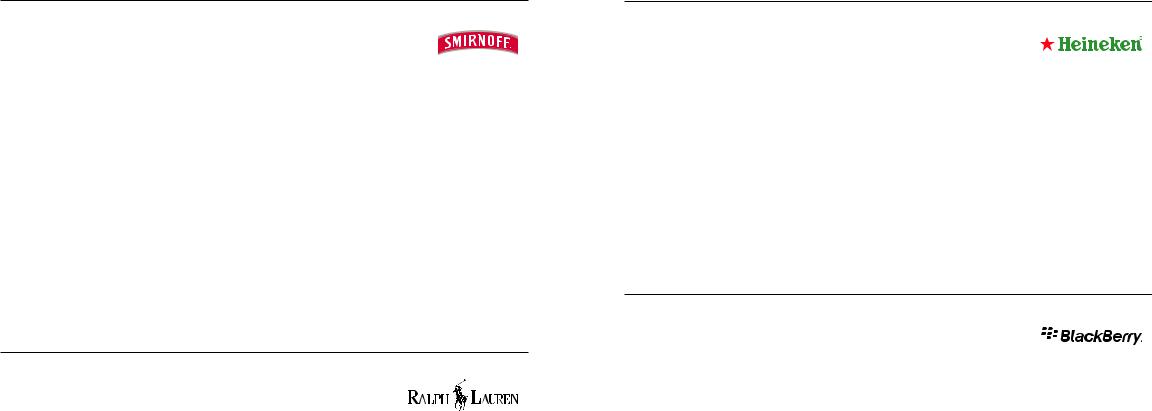
90
Smirno
+5%
4,050 $m
Smirno ’s parent company, Diageo, describes the brand as being“the world’s best selling premium distilled spirit” — and for good reason.
Accelerated growth in developed markets and double-digit growth in Africa and Latin America have made Smirno a star in the Diageo portfolio. As a result, Smirno ’s marketing spend was recently increased by 10%. And Smirno is likely to put the extra funding to good use. Falling in line with its Whipped Cream and Flu ed Marshmallow flavored vodka launches and its “Nightlife Exchange Project,” Smirno announced plans to collaborate with photographer David LaChapelle to launch“Smirno Midnight Circus,” a global tour that will celebrate nightlife experiences in cities around the world. Smirno ’s
website also has strong global appeal. It not only boasts a section featuring Smirno -infused “cocktails from around the globe,” but it also provides consumers with a“nightlife guide” that contains information on the world’s“best bars, clubs, eateries, [and] special places.” Despite having originated in Russia in the 1800s, Smirno remains highly relevant to its consumers in the 21st century. It presents them with the information they need to plan — or just dream about — a thrilling night out in any number of the world’s most exciting cities. Clearly, Smirno is dedicated to building
relevant, self-expressive and exciting experiences for its consumers worldwide.
91
Ralph Lauren
New
4,038 $m
An iconic fashion brand that embodies timeless style, Ralph Lauren excels at creating stories around its merchandise by using technology and creativity. Making its first reappearance in the top 100 since 2009, Ralph Lauren’s record brand growth in the past year can be attributed to highly innovative communication patterns and consistency across all touchpoints and formats. At the forefront of the digital movement since the beginning, the brand saw the digital revolution as an opportunity to tell a story online when many fashion retailers saw the internet as a threat to store sales. Over the years, Ralph Lauren has invested heavily in video, editorial content, a Minority Report-inspired interactive store window, mobile apps, and a 4D“visual feast” in the streets of London and New York fusing art, fashion, and technology. Most recently, the brand used Fashion Week as an opportunity to
buy out all the ad space in The New York Times iPad app for the entire month of September. Building on its well-established sporting heritage, Ralph Lauren has entered new team sponsorships and outfitting agreements, including a five-year contract with the US Golf Association as its o cial outfitter and on-site apparel supplier. Expected to bolster its all-American image, the brand accepted the honor of being the US Olympic team’s o cial outfitter as well. Unfortunately, bringing a bit of tarnish to an otherwise exemplary year, outrage ensued when it was revealed that Team USA’s RL uniforms were, in fact, made in China. While there are many things Ralph Lauren is doing right, in order to sustain its strong brand growth and integrity, the brand will have to make transparency a top priority.
92
Heineken
+3%
3,939 $m
One of the world’s most recognized premium beer brands, Heineken continues to aggressively stay in front of the market. With its recent e orts to acquire the remaining shares of the Tiger beer operation in Thailand, Heineken has proven it’s serious about solidifying its operational presence in Asia. The brand also continues to develop impactful and memorable global campaigns like the“Heineken Star Serve,” which, appealing to both consumers and beverage servers, advises on how to tap and serve the perfect draught beer. As this campaign illustrates, Heineken is
increasingly involving consumers in its business processes to stimulate worldwide conversation about the brand. From launching a website that allows consumers to discuss the perfect draught beer experience to its crowd-sourced nightclub concept that livened up Milan’s Design Week, Heineken is proving that it can mobilize and engage audiences worldwide. With more than five million fans, Heineken’s Facebook presence is more proof of the brand’s ongoing success with e orts to stay globally relevant while maintaining its premium status.
93
BlackBerry
–39%
3,922 $m
It has been a tumultuous year for the BlackBerry brand. In a category that is driven more by design and user experience, BlackBerry is struggling to find a point of di erence beyond security, BBM, and its physical QWERTY keyboards — none of which are capable of being secure, long-term advantages. A change of leadership early in the year provided hope that the company had found a new lease
on life. New CEO Thorsten Heins’ decision to “stay the course,” however, illustrated a reluctance to take a risk on self-reinvention and transformation — traits that are essential for survival in today’s hyper-competitive consumer electronics market. As such, the brand remains locked in an identity crisis. Despite its longstanding association with the B2B market, customers are struggling to understand what
BlackBerry stands for, just as its parent company struggles to do the same internally. The company is plagued with underwhelming product launches, undelivered promises (BlackBerry 10 has been delayed yet again, to 2013), and inconsistent marketing campaigns. Without having a clear core idea or platform upon which to build and rally behind, it is increasingly di cult to understand the company’s direction. BlackBerry shipments are down 41% in the past year, and market share now stands at 4.8% globally. In order to survive, the brand must demonstrate relevance in the crowded smartphone market. If BlackBerry can deliver a truly innovative experience designed for today’s mobile professional, it will send the message that the brand is committed to the B2B market that once made it such a success.
66 |
Best Global Brands 2012 |
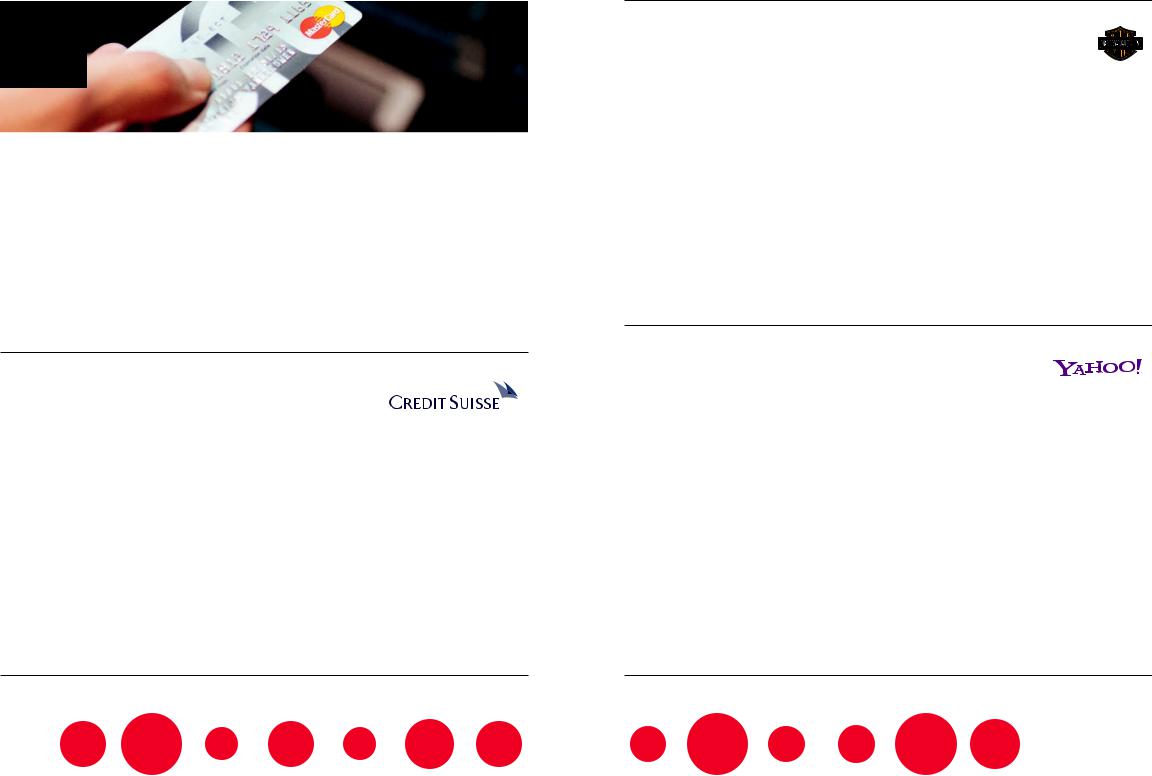
94
Mastercard
New
3,896 $m
MasterCard makes its debut in our Best Global Brands report after an impressive year. The company’s leadership in mobile payment via MasterCard PayPass, the launch of its“Priceless Cities” customer benefits program, and a growing suite of solutions for business owners are steadily increasing consumer satisfaction. MasterCard gained market share from Visa over the past year in spending volume, new bank tie-ups (notably SunTrust and Sovereign in the US) and new card users. The brand’s“Priceless” tagline and accompanying slogan have resonated
and succeeded in building emotional connections between MasterCard and consumers over time. Now reaping more of the benefits of those connections, MasterCard needs to continue delivering meaningful results. Despite a positive year overall, a third party data breach exposed the account information of millions of customers. As one of the world’s largest payment processors, MasterCard must work diligently to ensure its customers’ information is protected and that their experiences with the brand remain positive.
95
Credit Suisse
–5%
3,866 $m
This year, Credit Suisse launched a bold advertising campaign, aimed at positioning the firm as a luxury brand. It replaced its Roger Federer “Relaxed” with“The Roger Federer World Tour 2012” — and not a moment too soon.“Relaxed” may not be the right vibe for a global banking leader at this particular moment in history. Like other banks, Credit Suisse has been bu eted by the e ects of a slow-starting US economy, the European debt crisis, and many unknowns in Asia. The brand’s new financial reality — declines in both revenue and margins — has led to cuts in global headcount and the Swiss National Bank’s recommendation to‘’significantly expand its
loss-absorbing capital during the current year.’’ Considering the challenges, the bank’s ability to hold steady is impressive. The brand has retained relevance through its continued transition to a more client-focused model, a critical move given the upheaval within its sector. This model extends to the brand’s corporate citizenship e ort, use of social media channels and a multi-year talent and cultural-building e ort. The hard work has paid o . This year, Credit Suisse stands as the lone representative of the Swiss banking tradition among the world’s brand elite.
Automotive
$7.1b $29b $3.7b $7.9b $3.8b $17.2b $7.4b
Audi BMW Ferrari Ford Harley-Davidson Honda Hyundai
96
Harley-Davidson
+10%
3,857 $m
After nearly three years of restructuring its business, Harley-Davidson has emerged with confidence and focus. The strategy seems to be paying o with signs of solid performance and consistent growth. Even through challenging economic times, there remains a strong sense of community among Harley-Davidson fans. Knowing that it cannot solely rely on baby boomers, the company has been working hard to appeal to women, minorities, Gen Y, and Millennials. The challenge for the brand will be in balancing traditional audiences with the new audience segments. These newcomers to Harley Davidson, however, are embracing the brand
with passion and enthusiasm. Of its 3.6 million Facebook fans, 40% are aged 18–34. The organization has also shed non-Harley-Davidson brands and put its e orts into a unified brand experience. This focus has helped to build momentum in share gains, retail sales, and profit in outreach markets. Despite strong competition from Japanese manufacturers, Harley-Davidson opened 35 dealerships in international markets, including Mexico, India, Turkey, Russia, China, and Brazil. With a solid strategy in place, Harley-Davidson appears poised to conquer the open road.
97
Yahoo!
–13%
3,851 $m
A brand that had a hand in defining the internet before the age of Google, Yahoo has been on the decline for the past 10 years. Although the web portal pioneer is the fourth-largest site on the internet and has an audience of millions, it has been making news not for its achievements, but for its missteps. Yahoo struggles to compete in search, email, and data sharing. Acquisitions, such as Flickr, have been underutilized. Without fully developing social elements, Flickr ceded ground to Facebook and Instagram. On top of that, Yahoo’s revenues have been waning for years and its content, while a dominant force in online news, needs to evolve. Potential buyers
have been circling the troubled company for the past two years and, so far, no one has been able to revive the ailing brand. Enter Marissa Mayer — a former Google executive, now Yahoo’s CEO. A bold hire by anyone’s estimation, there is now more hope than ever for a turnaround at Yahoo. Indeed, the company has potential to make a comeback: it has strong brand recognition, a vast audience, and despite challenges, revenues are up. Yahoo must realize that the content it’s now developing will come to define it as a brand and that, in a world overflowing with information, di erentiation has never been more important.
$4.0b $30.0b $4.9b $5.1b $30.2b $9.2b
Kia Mercedes-Benz Nissan Porsche Toyota Volkswagen
68 |
Best Global Brands 2012 |
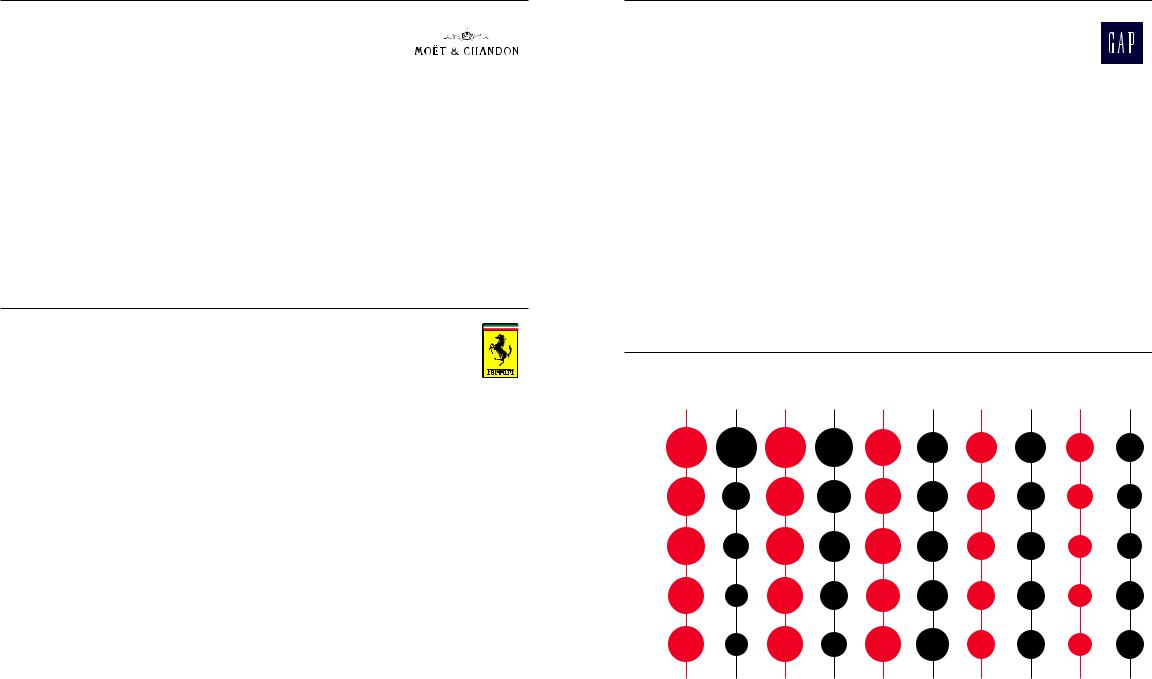
98
Moët & Chandon
–13%
3,824 $m
Moët & Chandon has helped its consumers celebrate success and glamour since 1743. In the past year, the brand played an active role in the opening of LVMH’s White 1921, a boutique
hotel and bar located in the heart of Saint-Tropez. With an 82-seat bar, White 1921 guests are able to leisurely sip Moët Imperial Vintage from 1921.
Moët & Chandon also launched its 2012 Moët Rose Lounge Series, a celebrity-hosted, supper club-style tour featuring Moët Nectar Imperial Rose. In the year head, Moët & Chandon will serve as the o cial champagne of the 34th America’s Cup. With its US division having
recently hired a new digital advertising agency and having increased its media spend, Moët & Chandon appears ready to grab consumers’ attention — not only on the beaches of SaintTropez and through celebrity-hosted tours, but on the digital forefront as well. If it can successfully strike a balance between maintaining its enviable heritage while simultaneously becoming digitally aggressive, Moët & Chandon might very well be able to restore some of its brand value in the year ahead — an accomplishment that will definitely be worth toasting.
99
Ferrari
+5%
3,770 $m
Ferrari is an iconic automotive brand that can be best described as one that passionately pursues perfection. In its latest quest to move the high-performance category forward, Ferrari announced that it will o er its first gasolineelectric hybrid vehicle next year. This vehicle will replace the limited edition Enzo and inject its Formula One power in creating the fastest, most powerful road car ever — while slashing fuel consumption. These are the types of bold ambitions and stories that energize the Ferrari community and generate hours upon hours of
conversations in social media. While Ferrari’s home country of Italy is one of the strongholds in supercars, a crackdown on luxury goods and scrutiny of supercar owners has had a negative impact on sales there. China, however, is Ferrari’s second-biggest market and the brand continues to expand at a rapid pace with new dealerships and increased sales. With new
and renewed licensing deals, Ferrari is as strong as ever and continues to find new ways to
excel as one of the world’s most legendary automotive brands.
100
Gap
–8%
3,731 $m
The Gap brand has experienced rocky times in recent years, as the business concept has been successfully copied and revamped by trendier competitors like H&M, Zara, and Uniqlo. Gap has also struggled with a blurred brand vision and lack of design originality. Consequently, the world has watched Gap’s steady fall from grace, and consumers are reluctant to keep the faith to a brand once considered the king of retail apparel. In response, Gap is now focusing its e orts on reconnecting with its Californian roots, and staying true to the iconic casual style, built on jeans and t-shirts, that made it so popular in the 1980s and 1990s. The brand is expanding in Asia and its dedicated Chinese e-commerce site has
logged orders from over 330 cities across the country. Its partnership with China’s e-commerce leader, Toabao Mall, will allow Gap to reach an additional 370 million consumers. In addition, Gap plans to open 45 stores in China by the end of 2012. Indications show that Gap has been picking up speed after launching a
global branding campaign — sales have increased and profits remain stable. By steering away from the“fast fashion” approach common to its competitors and committing itself to longerlasting consumer pleasure through colors, fabrics, and a return to iconic classic styles, Gap will get another chance to reclaim the retail apparel throne.
Top 10 Brands
2012 |
$77.8b |
$76.5b |
$75.5b |
$69.7b |
$57.8b |
$43.6b |
$40.0b |
$39.3b |
$32.8b |
$30.0b |
2011 |
$71.8b |
$33.4b |
$69.9b |
$55.3b |
$59.0b |
$42.8b |
$35.5b |
$35.2b |
$23.4b |
$27.7b |
2010 |
$70.4b |
$21.1b |
$64.7b |
$43.5b |
$60.8b |
$42.8b |
$33.5b |
$32.0b |
$19.4b |
$26.1b |
2009 |
$68.7b |
$15.4b |
$60.2b |
$31.9b |
$56.6b |
$47.7b |
$32.2b |
$30.6b |
$17.5b |
$31.3b |
2008 |
$66.6b |
$13.7b |
$59.0b |
$25.5b |
$59.0b |
$53.0b |
$31.0b |
$31.2b |
$17.6b |
$34.0b |
|
Coca-Cola |
Apple |
IBM |
Microsoft |
GE |
McDonald‘s |
Intel |
Samsung |
Toyota |
Best Global Brands 2012
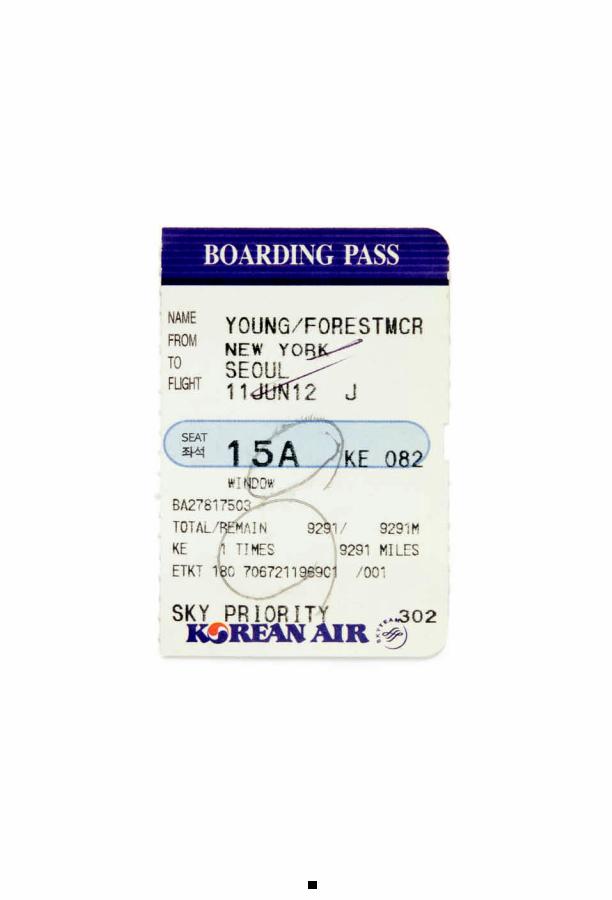
Survival of the Smartest
By Stuart Green
Globally, the airline industry remains in a fragile state. The industry continues to face challenges from macroeconomic uncertainties, especially within the Eurozone, as well as intense competition and rising fuel costs. Fuel now accounts for a third of every airline’s costs, up from 13% a decade ago. The International Air Transportation Association (IATA) estimates that total airline profits for 2012 will be USD $3 billion, down from the estimated $7.9 billion in 2011. In fact, the airline industry has su ered a multi-million-dollar global loss in seven of the past
12 years.
Best Global Brands 2012 / Airlines

Compounding matters, the EU has unilaterally decided to levy a carbon tax. Though airlines have been steadily implementing and achieving environmental goals in recent years, there is friction over the carbon tax plan, a scheme that requires airlines flying within, to, and from the EU to monitor their CO2 emissions and, if necessary, pay for the exceeding carbon allowances. However, despite disputes from the industry,“climate politics” will continue to be an issue for airlines as pressure to curb emissions mounts.
With many airlines bleeding money and drastically cutting back on costs, 2012 has largely been about survival. Fragmented and populated with too many players, the industry is struggling to find its balance as the traditional business model shifts from a focus
on market share to a focus on profitability. Consolidation is inevitable to remove excess capacity in the industry, especially as government aid dries up in key markets.
A few bright spots
There are, however, a few bright spots: Asia will still be the most profitable region
this year despite the impact of the Eurozone, and an economic slowdown in India and China. Intra-Asia air tra c, driven by the economic growth in the region, remains strong and is growing. Furthermore, there has been a rebound in demand from the Japanese market following last year’s earthquake. North America will account for nearly half of the USD $3 billion dollar global industry profits. US airlines have benefited from a relatively strong domestic market with a focus on ancillary revenues, and sophisticated rewards and merchandising programs. The Middle East has experienced a sharp decline in profitability due to a heavy exposure to European air tra c. However, despite this, it is the Middle Eastern airlines that are driving consolidation and securing key positions globally. They also continue to out-
spend their competitors when it comes to new aircraft, passenger comfort, and technology.
Driving demand by leveraging the customer experience
Never before have airline customers been so diverse, informed, fickle, and demanding. Airlines that do manage to please make considerable e ort to focus on the desired customer experience. They also deliver changes based on what’s critical, and avoid time and e ort spent on what’s not.
These more“experiential” focused airlines know that customers want brand experiences that are relevant and appropriate — not just at a point in time, but on an ongoing basis, and often customized to their liking. Rather than weigh business decisions against the multitude of external factors out of their control (high operating costs, regulations, an ever-changing economy), these airlines use their brand as a decision filter and act with confidence that they’ll deliver what their customers desire. Here are just a few of the experiential innovations taking place in 2012:
Qatar Airways prepares inflight meals for Business Class passengers from the time of order. The airline has also teamed up with well-being guru, Deepak Chopra, to produce a “Tips to Fly Healthy” guide that can be found in the seatback pocket. Qatar will also be the first Middle Eastern airline to have launched the Dreamliner this summer. The aircraft will feature“TouchPMU,” an iPhone-like device that allows passengers to multitask and watch movies.
Virgin America is the only airline in the US that o ers USB outlets in all seats and o ers inflight WiFi. Adding personality and playfulness to the experience, one of its aircrafts pays homage to Steve Jobs by having his famous quote “Stay Hungry, Stay Foolish” painted on its side. Another aircraft is named“NerdBird” as a result of its high number of WiFi users traveling on the San Francisco-to-Boston route.
A key service di erentiator is the airline’s inflight entertainment and communications
system, known as“Red.” The nine-inch highdefinition touchscreens feature live satellite television, the first ever seatback digital shopping platform, an open tab service, and interactive Google Maps with terrain view that tracks the flight’s location. Passengers can also use the system to chat with other passengers, play 3D games such as Doom, o set carbon emissions for their flight, or purchase snacks, meals, and beverages. Flight attendants receive orders via a tablet device, and bring any ordered items directly to the passenger’s seat.
Korean Air is known to be the world’s most successful inflight retailer and has the lowest seat density on its A380s among all airlines. Sacrificing revenue from 13 seats to make way for the“first flying duty-free shop,” Korean Air has created Absolut Vodka-branded bars and lounges that incorporate display units of dutyfree goods. Duty-free o erings are showcased so passengers can sample the best-selling items before making a purchase. Any order placed is then delivered to the passenger’s seat.
British Airways is investing in additional training for its crew and equipping them with iPads to ensure the delivery of outstanding customer service. The iPads have apps that enable the attendants to store and receive relevant passenger details in real-time,
such as travel itineraries and meal preferences, to allow for more customized service. The devices also show details of the inflight menu with pictures, as well as pre-loaded information about the arrival destination so attendants can give travel advice and recommendations.
Delta Airlines is the first to roll out mobile bag-tracking capabilities via its Delta app for smartphones, allowing passengers to track checked baggage in real time. The airline also introduced a premium service with Porsche at its Atlanta hub for its highest-tier Diamond Medallion customers. Selected arriving passengers are escorted from the plane to a waiting Porsche vehicle for a ride to their parked cars or other terminals for connecting flights.
KLM is di erentiating the passenger experience by enhancing its cultural touchpoints and use of social media. In order to make Chinese passengers feel at home, KLM has localized elements of the onboard experience on flights to and from China. Each flight has three Chinese-speaking cabin crewmembers onboard; announcements are also made in Mandarin and Cantonese, while language assistants are available to assist passengers upon departure and arrival. In addition, KLM’s social media hub strives to answer every customer message via Twitter and Facebook personally, within an hour,
24 hours a day, seven days a week, in Dutch, English, German, or Spanish.
Though current conditions are not ideal for the airline industry, there is certainly ample opportunity to rethink strategy and put more emphasis on profitability. Airline marketers who focus on enhancing their brand’s customer experience can benefit from competitive di erentiation, increased
brand loyalty, advocacy, and revenue growth. There’s never been a more important
time in the airline industry to focus on understanding customers and improving their experience.
—Stuart Green, Chief Executive O cer, Interbrand Asia Pacific
Best Global Brands 2012 / Airlines

You Are What You Wear
By Bertrand Chovet
With consumers seeking value for money and businesses hit by higher cotton prices, the apparel sector faces fundamental challenges. Fashion is moving fast, and consumers move even faster when making purchase
decisions. Tracking, anticipating, answering, and connecting with shopper behaviors throughout the purchase journey is more critical than ever. To stay in the game, brands need to demonstrate value across all digital and physical touchpoints.
With the soaring price of raw materials, fast fashion brands have to rethink their low-cost strategies and respond quickly to changes in the market. Due to volatile exchange rates and higher labor costs in Asian markets, apparel brands are also exposed to increasingly fierce competition and face the prospect of losing their competitive advantage.
Apparel has su ered from the recession and brands are responding in various ways. Gap is reducing square footage in the US while accelerating store openings in China. Brands such as H&M have not increased their prices to protect their brand position in accessible fashion. Consequently, H&M’s profits have decreased. And Levi’s launched dENIZEN, a global initiative to engage a new generation of denim buyers. It meets customer needs for value while protecting the brand’s premium image. Defending a premium through behaviors, product, or experience is a key requirement for strong brands.
Digital developments
The battle for omni-channel (seamless) retailing has begun. Zara’s online store ensures that the customer’s journey delivers an experience consistent with its physical stores. The brand’s“Dear America” campaign was a key moment in building presence. By inviting 50 photographers to photograph each US state, Zara gained local and national attention. H&M’s online shop features the “Dressing Room” which enables consumers to dress a virtual model in pieces from the retailer’s latest collection.
Touching customers’ lives
Strong brands are moving forward with shopping applications to capture and transform purchase decisions. However, Interbrand has noticed that shoppers expect a richer
experience that reflects their taste and values, which means retailers will have to rethink old strategies and develop more organic, thoughtful approaches.
In March 2012, Zara reopened its flagship on New York’s Fifth Avenue, showcasing a revamped architecture and interior scheme. Its innovative approach to interior design is based on four principles: beauty, clarity, functionality, and sustainability – making the brand the best in class for shopping
experience. Alongside this, the brand’s Dear New York events, echoing the Dear America campaign, demonstrated that the brand has a real feel for its customers’ interests and a flair for building relationships with them.
Sustainability and corporate citizenship are high on the agenda for all leading apparel brands. H&M presented several initiatives, such as its Conscious Collection and H&M Fashion Against AIDS. The retailer is also now the world’s largest user of organic cotton.
In 2011, Levi’s introduced the Water<LESS initiative, using up to 96% less water to make its jeans. The initiative also challenged consumers to shower and launder less often. Consumers in more than 1,300 cities around the world rose to this challenge, engaging around shared concerns.
Because apparel reflects the personalities of consumers, this category o ers many opportunities for brands to develop deep connections with their core audiences. At
Interbrand, we believe the way forward is to use digital and physical channels to develop a rich customer experience.
Best Global Brands 2012 / Apparel
